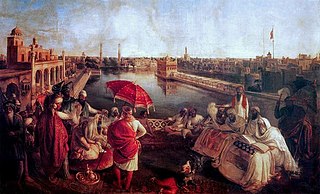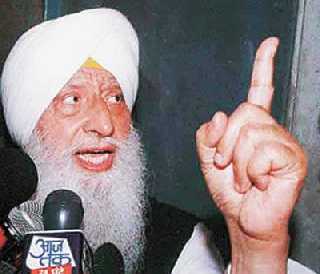Flag of Punjab may refer to:
- Flag of Punjab, India, a symbol of Punjab, State of India (Charda Punjab)
- Flag of Punjab, Pakistan, a symbol of Punjab, Province of Pakistan (Lahnda Punjab)
Flag of Punjab may refer to:

Sikhs are an ethnoreligious group who adhere to Sikhism, a Dharmic religion that originated in the late 15th century in the Punjab region of the Indian subcontinent, based on the revelation of Guru Nanak. The term Sikh has its origin in the Sanskrit word śiṣya, meaning ‘seeker’, 'disciple' or 'student'. According to Article I of Chapter 1 of the Sikh Rehat Maryada, the definition of Sikh is: Any human being who faithfully believes in

The Khalistan movement is a separatist movement seeking to create a homeland for Sikhs by establishing an ethno‐religious sovereign state called Khalistan in the Punjab region. The proposed boundaries of Khalistan vary between different groups; some suggest the entirety of the Sikh-majority Indian state of Punjab, while larger claims include Pakistani Punjab and other parts of North India such as Chandigarh, Haryana, and Himachal Pradesh. Shimla and Lahore have been proposed as the capital of Khalistan.

Sialkot is a city located in Punjab, Pakistan. It is the capital of the Sialkot District and is the 13th most populous city in Pakistan. The boundaries of Sialkot are joined with Jammu in the north east, the districts of Narowal in the southeast, Gujranwala in the southwest and Gujrat in the northwest.
PU, Pu, or pu may refer to:

The Radcliffe Line was the boundary demarcated between the Indian and Pakistani portions of the Punjab Province and Bengal Presidency of British India. It was named after Cyril Radcliffe, who, as the joint chairman of the two boundary commissions for the two provinces, had the ultimate responsibility to equitably divide 175,000 square miles (450,000 km2) of territory with 88 million people.
Punjab Province may refer to:

Wagah, also spelled Wagha, is a village and union council located in the WahgaZone near Lahore City District, Pakistan. The town is famous for the Wagah border ceremony and also serves as a goods transit terminal and a railway station between Pakistan and India. Wahga is situated 600 metres (2,000 ft) west of the border and lies on the historic Grand Trunk Road between Lahore and Amritsar in India. The border is located 24 kilometres (15 mi) from Lahore and 32 kilometres (20 mi) from Amritsar. It is also 3 kilometres (1.9 mi) from the bordering village of Attari, India. The Wagah ceremony takes place every evening.
Khosa may refer to:

The Khaksar movement was a social movement based in Lahore, Punjab, British India, established by Inayatullah Khan Mashriqi in 1931, with the aim of freeing India from the rule of the British Empire.

Khanewal is a city and the capital of Khanewal District in Punjab, Pakistan. It is the 36th largest city of Pakistan by population.

Jagjit Singh Chohan was a major Sikh leader of the Khalistan movement that sought to create a sovereign Sikh state in the Punjab region of the Indian subcontinent. Chohan established the Council of Khalistan at Anandpur Sahib on 12 April 1980 and became its first self‐styled president.
Pakistan has several official national symbols including a flag, an emblem, an anthem, a memorial tower as well as several national heroes. The symbols were adopted at various stages in the existence of Pakistan and there are various rules and regulations governing their definition or use. The oldest symbol is the Lahore Resolution, adopted by the All India Muslim League on 23 March 1940, and which presented the official demand for the creation of a separate country for the Muslims of India. The Minar-e-Pakistan memorial tower which was built in 1968 on the site where the Lahore Resolution was passed. The national flag was adopted just before independence was achieved on 14 August 1947. The national anthem and the state emblem were each adopted in 1954. There are also several other symbols including the national animal, bird, flower and tree.

The India–Pakistan, Indo–Pakistani or Pakistani-Indian border is the international boundary that separates the nations of the Republic of India and the Islamic Republic of Pakistan. At its northern end is the Line of Control, which separates Indian-administered Kashmir from Pakistani-administered Kashmir; and at its southern end is Sir Creek, a tidal estuary in the Rann of Kutch between the Indian state of Gujarat and the Pakistani province of Sindh.
Cheema is a Punjabi Jat clan of India and Pakistan.

Fazilka, also known as Bangla, is a city and a municipal council in Fazilka district of Punjab, India. In 2011, it was made the headquarter of the newly created Fazilka district. The Trans-Afghanistan Pipeline (TAPI) project originating in Turkmenistan will have its last station in Fazilka.

Lal Chowk is a city square in Srinagar, Jammu and Kashmir, India.

Gurdwara Darbar Sahib Kartarpur, also called Kartarpur Sahib, is a gurdwara in Kartarpur, located in Shakargarh, Narowal District of Punjab, Pakistan. It is built on the historic site where the founder of Sikhism, Guru Nanak, settled and assembled the Sikh community after his missionary travels and lived for 18 years until his death in 1539. It is one of the holiest sites in Sikhism, alongside the Golden Temple in Amritsar and Gurdwara Janam Asthan in Nankana Sahib.
Muslim League may refer to:

The lowering of the flags ceremony at the Attari–Wagah border is a daily ceremony that the security forces of India and Pakistan have jointly followed since 1959. The drill is characterized by elaborate and rapid dance-like manoeuvres and raising legs as high as possible, which have been described as "colourful". It is both a symbol of the two countries’ rivalry, and a display of brotherhood and cooperation between the two nations.

The Amritsar–Pathankot line is a railway line connecting Amritsar and Pathankot Junction both in the Indian state of Punjab. The line is under the administrative jurisdiction of Northern Railway.